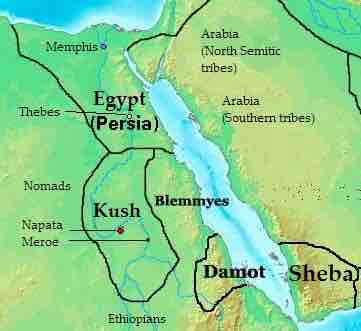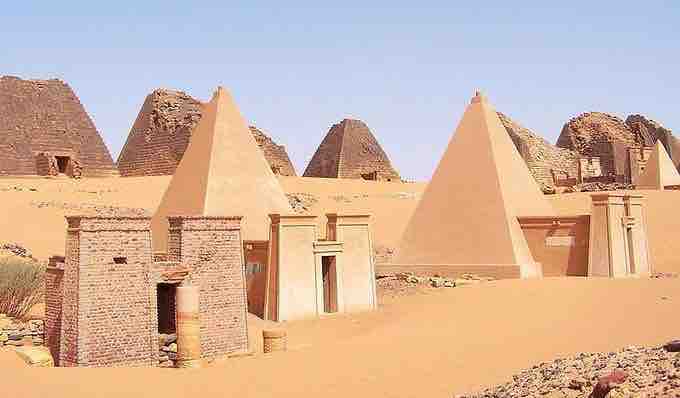The Kingdom of Kush was an ancient African state situated on the confluences of the Blue Nile, White Nile, and River Atbara in what is now the Republic of Sudan.

Africa in 400 BCE
Map of kingdoms, states, and tribes in 400 BCE Africa.
Established after the Bronze Age collapse and the disintegration of the New Kingdom of Egypt, Kush was centered at Napata in modern day northern Sudan in its early phase, and then moved further south to Meroë in 591 BCE. After king Kashta invaded Egypt in the eighth century BCE, the Kushite kings ruled as Pharaohs of the Twenty-Fifth Dynasty of Egypt for a century, until they were expelled by Psamtik I in 656 BCE. The reign of the Twenty-Fifth Dynasty ushered in a renaissance period for ancient Egypt, and art and architecture emulating the styles of the Old, Middle, and New Kingdoms flourished. Kushite pharaohs built and restored many temples and monuments throughout the Nile Valley, and the construction of Kushite pyramids became widespread. Some of these are still standing in modern Sudan.
Kushite Arts
The Kushite arts were inspired by the Egyptians, but were drastically African. Most remarkable among these was Kushite relief sculpture, which adorned the walls of palaces or pyramids. The cuts that are on the walls are deeper and more strategic than Egyptian hieroglyphics. There are many reliefs scattered across the land of Africa. They mostly depict scenes from African daily life and animals. Reliefs depicting battle scenes or kings are somewhat less common.
Statues of rulers and other royal individuals emphasize the foreign, non-Egyptian origin of their subjects. The Head of a Kushite Ruler (c. 716-702 BCE), identified by some scholars as King Shabaqa, depicts a man with a typically round Kushite face. Although his eyes bear resemblance to those of Egyptian individuals in art, his hairstyle and regalia are distinctly non-Egyptian. The front of his headband once featured two cobras. While Egyptian pharaohs commonly wore a single cobra on their headgear, the double-cobra motif was unique to the Kushite culture.
Head of a Kushite Ruler (c. 716–702 BCE)
This sculpture combines Egyptian and unique Kushite attributes.
Pottery was another important Kushite craft and consisted mostly of pots and bowls that were shaped from clay and then painted in many different colors. Most pottery was initially made for the wealthy, but later on, many commoners also began using pottery in their households. While decoration usually took the form of painted designs, some types of pottery also had stamped designs. Common motifs included geometric and plant-based patterns. The finest pottery was decorated with paintings of animals, such as giraffes, antelopes, frogs, crocodiles, snakes, and a variety of birds.
Kushite Architecture
The kings of Kush adopted the Egyptian architectural idea of building pyramids as funerary monuments. However, Kushite pyramids were built above the underground graves, whereas the Egyptian graves were inside the pyramid. The kings' tombs were lodged under large pyramids made of stone. For a short time, the Kushite kings were mummified. Ordinary citizens were buried in much smaller pyramids. The most famous examples of Kushite pyramids are located in their capital Meroë. There are three cemeteries in Meroë; the north and south cemeteries are royal cemeteries and house the pyramids of kings and queens, whereas the west cemetery is a purely non-royal site.

Sudan Meroë pyramids
Sudan Meroë pyramids — UNESCO World Heritage.